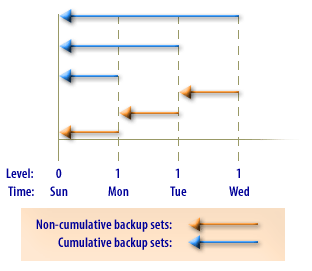| Lesson 6 | Backup sets |
| Objective | Discuss how backup sets are used within Recovery Manager. |
Oracle Backup Sets
In this lesson, we will review some of the terminology used with Recovery Manager that is necessary to understanding the material in later lessons.
Recovery Manager supports two basic backup types:
Recovery Manager supports two basic backup types:
- backup sets and
- image copies.
Backup sets and backup pieces
A backup set contains one type of object, either data files or archive log files, but not both.
This makes it easier to manage your backup and recovery components. A backup set contains all the pieces that make up a full or incremental backup.
The pieces of a backup set can be created in parallel, and Recovery Manager can perform this partitioning automatically for you.
Backup sets maybe multiplexed, meaning that blocks from different files will be interspersed within the new file.
Multiplexing means that you can manage one file rather than multiple files.
A backup set is made up of one or more backup pieces. Each backup piece is a single output file. Each backup piece contains control and checksum [1] information to validate the piece during a restore operation.
A backup set is made up of one or more backup pieces. Each backup piece is a single output file. Each backup piece contains control and checksum [1] information to validate the piece during a restore operation.
Full and incremental backup sets
A full backup set copies all blocks, skipping the data file blocks that have never been used. Archive log backup sets are always
full backups. An incremental backup set contains only the blocks that have been modified since the previous backup of the same or
lower backup level.
Full and incremental backups work hand in hand. A full backup will always restore your database to a useable state. Full backups are run during lower activity periods because they consume more resources and take longer to perform than incremental backups. Incremental backups alone are not sufficient to restore a database to a useable state, but they can be run in higher activity times, consume fewer resources, and take less time.
Full and incremental backups work hand in hand. A full backup will always restore your database to a useable state. Full backups are run during lower activity periods because they consume more resources and take longer to perform than incremental backups. Incremental backups alone are not sufficient to restore a database to a useable state, but they can be run in higher activity times, consume fewer resources, and take less time.
Multilevel incremental backup sets
With Recovery Manager, you have the ability to indicate different levels of incremental backups.
For instance, a level 0 backup copies all data blocks in use. This becomes the base level for incremental backups greater than 0. A level 1 backup copies only those blocks that have changed since the previous level 1 or level 0 backup.
Using multilevel incremental backup sets will help minimize resource consumption and backup time.
Using multilevel incremental backup sets will help minimize resource consumption and backup time.
Cumulative incremental backup sets
Cumulative incremental backup sets copy data blocks that have been modified since the last lower-level incremental backup at level 1 or greater.
In practice, cumulative incremental backup sets work when you have done a level 0 base level backup. From there, you perform a level 1 backup, which copies the data blocks that have changed since your level 0 backup. Then you perform another level 1 backup, which will copy all the data blocks that have changed since your level 0 backup. Thus, the second level 1 backup copies the same data blocks as the first level 1 backup.
This graphic illustrates the differences between a noncumulative and a cumulative incremental backup.
In practice, cumulative incremental backup sets work when you have done a level 0 base level backup. From there, you perform a level 1 backup, which copies the data blocks that have changed since your level 0 backup. Then you perform another level 1 backup, which will copy all the data blocks that have changed since your level 0 backup. Thus, the second level 1 backup copies the same data blocks as the first level 1 backup.
This graphic illustrates the differences between a noncumulative and a cumulative incremental backup.

In the next lesson, we will introduce image copy backups.
[1]
checksum: A checksum is created by applying a formula to a set of information to generate a unique number.
Errors can be captured when the checksum stored with the data does not equal the checksum calculated when extracting the data.